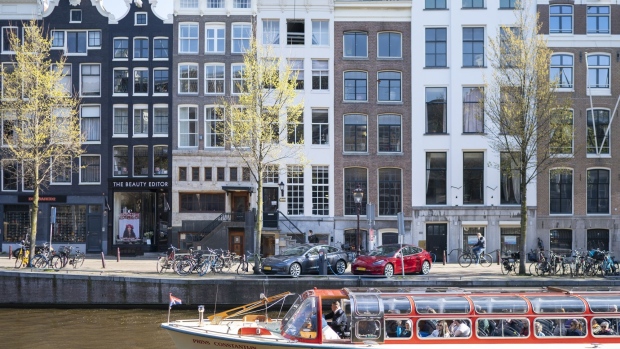Jun 2, 2022
Amsterdam’s Clogged Grid Is Putting Zero-Emission Dreams at Risk
, Bloomberg News

(Bloomberg) -- Amsterdam officials warn the city will miss its targets to decarbonize transportation if the central government does not help solve bottlenecks in the overloaded power grid.
The rapid rise in intermittent power sources from solar and wind, the push to build more houses and a society more dependent on electrical devices than ever before are contributing to the growing pressure on the Dutch capital’s grid. The city said it needs help from the government to achieve its goal of reducing emissions by 55% in 2030, compared with 1990 levels. Meanwhile, the grid operator is suffering from a lack of supplies and people to boost capacity in time to meet the growing demand.
The grid is already close to maximum capacity, making the city’s plans for fully electrifying public transport appear impossible, said a municipality spokesperson. The municipality wants grid access applications that are of major social importance, such as a school or a supermarket in a new district, to be prioritized. Currently only network operators can manage the order of applications and by law they must do so on a first-come, first-served basis. Amsterdam wants the central government to step in and change this.
“We are seeing a big technical shortage,” grid operator Liander NV’s spokesperson Peter Hofland said in an interview. “The waiting times for houses with a big electricity demand will grow longer and longer over the next years.”
Hofland said businesses are on the waiting list as well, and in certain areas companies cannot get extra capacity for an additional industrial warehouse with machines. “Half of the grid in Amsterdam is already full for large users of electricity,” he said.
Amsterdam recently lost out on a 130-million-euro ($138.5 million) investment when technology company TKH Group NV chose to build its new cable factory in Eemshaven, Groningen — over 200 kilometers (124 miles) away. It chose this location instead of the capital because of the lack of capacity from the power grid, according to the Port of Amsterdam, which is where TKH initially intended to build the factory.
Liander is set to invest 3.5 billion euros ($3.8 billion) by 2024 on the expansion of the power grid. Together with Dutch power company TenneT Holding BV, the network operator also plans to expand 12 existing stations in Amsterdam and build 29 new stations by 2035.
But a critical shortage of technicians, as well as raw materials for meters and cables, is putting the brakes on the development of the grid, Hofland said, adding that grid operators need to hire 13,000 workers in the coming four years in order to meet their expansion goals.
While demand on the grid is increasing, Europe as a whole is trying to cut back on energy — especially from gas — amid Russia's war in Ukraine. Amsterdam has formed a task force with Liander, TenneT and the port of Amsterdam to find efficient ways to tackle the grid’s capacity issues.
The Dutch government recently announced it will become a mandatory requirement for homes to install hybrid heat pumps from 2026. It also plans to introduce stricter rules from 2025 for large commercial buildings to have solar panels. But both these decisions will likely increase the pressure on the power grid, said Hofland.
Hofland said Liander supports more solar panels being connected to the grid but he says there are still technical solutions needed to make sure more of the electricity generated from these sources reach the end user — as this process lacks efficiency at the moment.
“If we don’t do this, we have to build the entire grid at the maximum peak that solar panels can generate,” he said. “In the Netherlands we all pay for the power grid which means we must use it smartly and this is what we’re asking the government to do.”
©2022 Bloomberg L.P.





